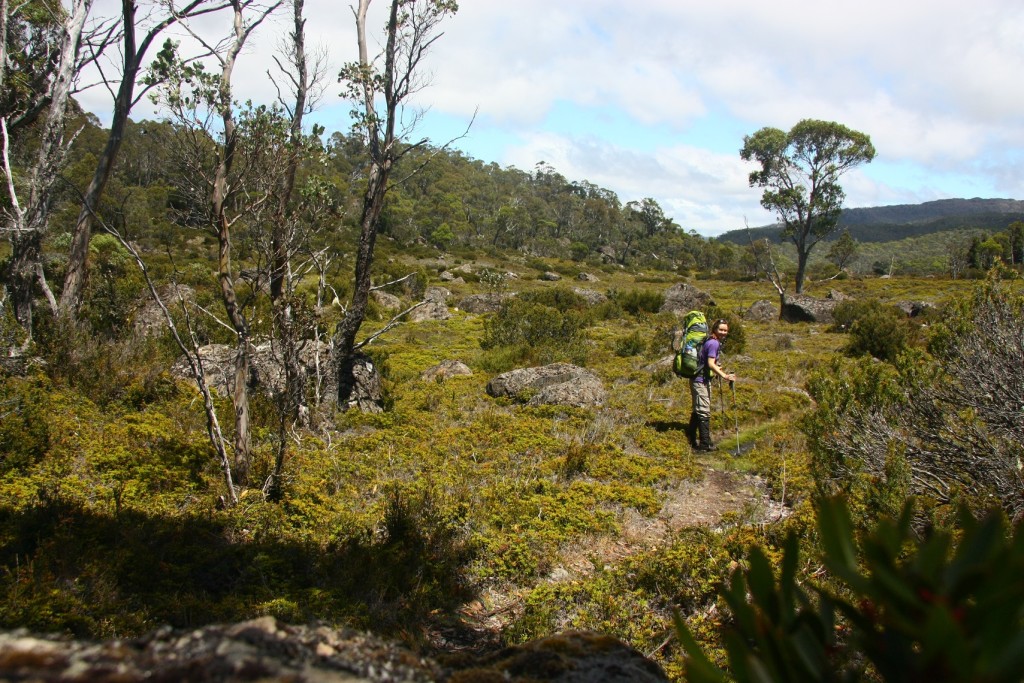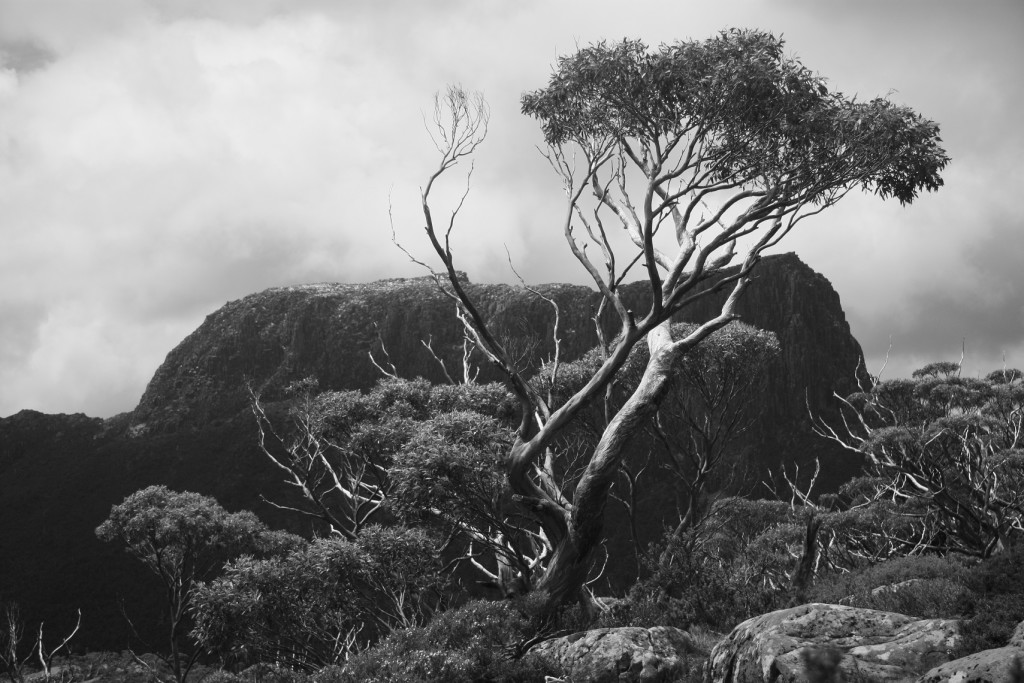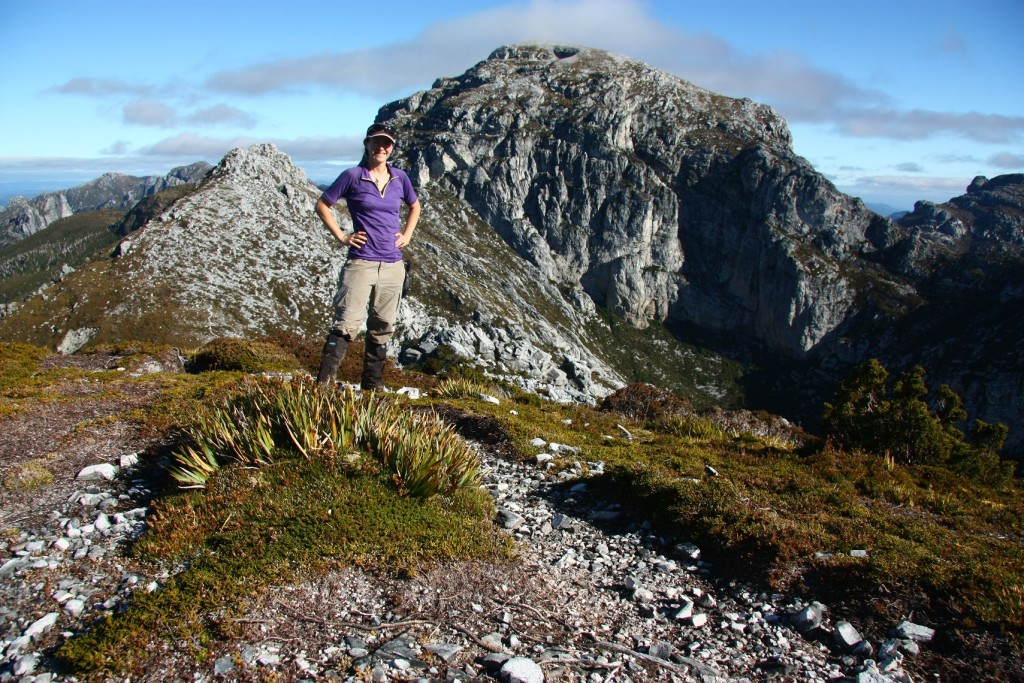I’m going to step back in time for a moment. About three weeks back, to the time that I was in Hobart, Tasmania, folding a strange man’s laundry.
Is this weird? This is weird, I thought to myself, but in a good way. Susan Munroe, professional houseguest; maybe I should put that on my resume. It has to be an uncommon talent: blending into the lives of the people I meet while traveling, building trust based on the briefest of interactions. I met Scott at the trailhead for Frenchman’s Cap, an iconic quartzite peak in the middle of Tasmania, Australia’s southernmost state. The tall strawberry-blonde was stuffing gear into a large pack at the same time as I was consulting my map and making the final adjustments on my own pack. It was late in the day, and we grinned at each other: neither of us had expected to see anyone else starting out at this hour. Scott proffered his hand and a bag of fresh cherries, and for the next four days we leapfrogged each other on the trail and camped at the same sites and shared our stories and appreciation of wild places. He invited me to stay at his house when I arrived in Hobart. “I won’t be there, but you’re welcome to make yourself at home. I’ve just sold the place, and all the furniture, so it’ll be a bit like camping, but the hot water’s on and there’s a washing machine.”
The washing machine, as it turned out, was full of Scott’s clothes. A good houseguest always tries to leave a place better than she finds it, and it was easy enough to hang the clothes on the line, and then take them down and fold them when my own clothes were dry, too. I’d been on the trail for 14 days, beginning in Walls of Jerusalem National Park, crossing into Cradle Mountain–Lake St. Clair National Park, finishing up with Frenchman’s Cap, and the hot shower and clean clothes more than made up for the lack of furniture. I made a little nest with my Thermarest and sleeping bag in the corner of the empty living room and sighed with deep contentment, digging in to a well-deserved, celebratory pint of ice cream.
My trip began as it ended, with me accepting the kind generosity of a stranger. There’s no public transportation into the Walls of Jerusalem. I took a bus as far I could, then sat by the road with my thumb out, knowing that there’d be other hikers going that way eventually. Instead it was Doug who stopped, in his bright blue Toyota Hilux, a retired truck driver and founder of the local photography club. He dropped me off in Mole Creek, a small settlement about a third of the way to my destination. I waved as Doug drove away, hiked out to the edge of town, and reassumed my position. It was late, and I was prepared to stay in town that night and try again the morning. But I’d only waited half an hour when a familiar blue Toyota pulled up. “I was thinking, you know, you’ll never get someone to take you all the way up there,” Doug said. “Come on. I’ll take you the rest of the way.” It was a long drive, along winding, eucalyptus-lined hills, down one dirt road and then another. “I was thinking about my daughter,” Doug said. “I’d want someone to do the same for her.”
Like a good houseguest, a hitchhiking passenger tries to find ways to relate to and to express gratitude to the driver offering the lift. I ask questions, and I listen to the responses, repaying the kindness with interest and attention. Sometimes they want to hear my story, but mostly I make it about them. Sometimes I think of myself as a chameleon, changing colors to blend in with my benefactor. This has taught me diplomacy, but I wonder if it’s made me too conciliatory, and emphasized my natural reluctance to assert my opinion. At times, too, I wonder if these ostensibly outgoing skills have trained me to live a more internal life, to withdraw from deep interaction with other people. These are the thoughts that roamed my brain that night as I hiked the six kilometers to my first camp within the Walls of Jerusalem.
It takes three or four days to get into the rhythm of a hike. Day one my mind is still tethered to the movements and responsibilities of the real world, my body unused to walking, my pack still heavy with 14 days of food and fuel. I set up on a tent platform in an established backcountry campsite, cooked dinner, and was watching the sunset across wooded dolerite hills, when the possums appeared. Clinging to the trees around my tent, scampering through the underbrush, and—Hey! Get out of there!—rummaging through my backpack. I packed my things, stuffed everything in the tent, and went to brush my teeth and pee before bed. I came back to find a possum under my rain fly, with his face through the hole that he’d chewed in the tent screen, a whisker away from tearing into my food bag. Thus began the battle of Wild Dog Campsite. I patched the hole with duct tape, and lay in the tent, listening for the patter of possum paws on the platform. I’d feel them push up against the body of the tent, and shove them away from the inside, or listen to the sniffsniffsniffsniffsnifsniffsniffsniffsniff of a marsupial snout on the trail of my food. A couple times I actually leapt out of the tent and chased them away with my Chaco sandal; once I even made contact with a furry rump as it ran in front of me. At best, though, the critters would retreat to the edge of the platform and hunch with eyes that glowed red in my headlamp, waiting for me to get bored and go back to bed so they could try again. Morning was a long time coming.
Day two of a long hike is the hardest. Muscles complain, the pack feels impossibly heavy, and if you’ve been fighting possums all night and are coming down with a head cold, the wonders of world tend to lose their luster. Still, the Walls are spectacular, and I took my time, passing beneath the sheer dolerite escarpments and across green peat bogs, climbing up to Solomon’s Throne for a 360° view of rocky highlands and peat-ringed tarns, like strings of pearls arrayed in a careless jumble. By day three, the body has accepted that this is what we’re doing, the brain is calmer, and the kilometers pass more easily. By day four, I’m on another plane of existence. It was appropriate, then, that this was the day I hiked out of the Walls of Jerusalem and dropped off the edge of the world into The Never Never.
The Never Never is a route unpublished in the guidebooks that follows the Mersey River from its headwaters through thick forest and peat bogs into Cradle Mountain–Lake St. Clair National Park. Following a faint path alongside Junction Lake, I slipped and picked my way down Clarke Falls, passing out of bright morning sunlight into the cool, mossy realm of the Mersey River. Mist floated between the trees and the Mersey roared off the edge of the falls, wrapping the forest in a cocoon of white noise. I worked to follow the nearly invisible trail, moving from shadowy riverbank to bright muddy peat bogs and back again. The trail vanished more than once, leaving me to thrash my way through overgrown thickets, branches slapping me in the face and catching on my pack, but the sound of the river was a constant, reassuring guide. In calm, wide sections, sunlight spotlighted the rocks of the riverbed through the tannin-stained water, like panels of abstract stained glass. The Never Never ended abruptly: one minute I was calf-deep in mud, head down to keep branches out of my eyes, and the next I was standing on a boardwalk. I was now on the Overland Track, the most famous hike in Tasmania, the centerpiece of Cradle Mountain–Lake St. Clair National Park.
Whereas the Walls of Jerusalem is maintained as wilderness, with minimal infrastructure, the Overland Track is maintained to the highest standard, with boardwalks, wide trails, huts, and composting toilets. Over days five, six, and seven I hiked among guided groups and independent trekkers, sharing the huts with people from Australia, Ireland, Chile, and Canada, telling stories and trading advice. Camaraderie grows quickly along any trail, where shared interests are obvious and the wilderness eliminates distractions. Passing others on the trail means pausing for a moment to say hello. Until day eight, when I hiked out of the park and started passing the day-walkers, couples and individuals less than half an hour away from their cars, who barely made eye contact as they hurried past. Ah yes, I thought. They haven’t been out here long enough. Extended backpacking trips clear my brain of this hurry; they simplify, distilling tasks and thoughts down to their simplest forms, making me appreciate the little things. A scrap of sunshine to warm my face on a cloudy mountain top. A dry sleeping bag. A stretch of level ground after a hard ascent.
My brush with civilization was brief: it lasted just long enough for me to hitch a ride from the end of the Overland Track to the start of the Frenchman’s Cap hike, where I met Scott. Day nine found me waking up next to the Lodden River, and day ten at the top of the Cap itself, a 300 meter (980 feet!) white quartzite half dome that dominates Tasmania’s western ranges, presiding over lakes hidden deep within steep, intersecting ridgelines. To the west I could see the Southern Ocean, to the northeast, the peaks of the Overland Track. What I couldn’t see were any signs of human development. Not even a contrail streaked the sky. Stretched before me were the nearly four million acres of the Tasmanian Wilderness World Heritage Area, over six thousand square miles set aside in recognition of their unique natural and cultural values. It was refreshing to see my values reflected within the Tasmanian culture, to see wilderness valued for its inherent worth rather than the sum of its extracted resources. I wish that Chile’s decision-makers could travel to Tasmania and New Zealand and see that there is money to be made in well-managed wilderness tourism.
The eleventh day it “mizzled”. Too thick to be mist, but not as aggressive as drizzle, moisture hung in thick curtains among the trees, collected on leaves and fronds and rocks. Frenchman’s Cap was lost in the clouds; even the lake at its base shifted in and out of view. I took advantage of the weather to rest, grateful for the well-appointed hut in which to pass the day. I scrounged for dry kindling to start the coal-burning heater, repaired my gear, read, drank tea, and wrote. I lifted down the hut log, a massive leather-bound tome with marbling along the page edges. Now this was a book. Poring over the entries, I took pleasure in the tradition of a hiker’s log, in reading the collective experiences of hikers over the years. The notes were predictable, repetitive, but powerful for their affirmation that yes, there is value in places like this, in reconnecting with the simplicity of going for a long walk and sleeping in the woods.
Descending over three days, with a side trip to see the Franklin River (the focal point of a pivotal hydroelectric debate in the 1980s), my pack light as air, I felt replenished. Another kind stranger (this time it was Greg, a truck driver) took me all the way back to Hobart, and I arrived at Scott’s empty house filthy and stinking on the outside but with a clean brain and a soul sparkling and renewed. This is the value of wilderness. John Muir wrote, “In every walk with nature one receives far more than he seeks.” Yes.



You’re a rock star, Susan!! I’m always amazed at the treks you take on your own. You’re super good at choosing the most unusual and the most beautiful. Again, thanks for taking us up that trail in Tasmania.
Have you seen “Wild”? I made me want to hike, even more than I already do… You make me want to hike, more than I already to!
Enjoy the walk!
Jul’
I couldnt agree more, a rock star alright.
Thats a wicked analogy
How often does someone take you on a journey with just the power of words and contemplation.
Keeps you riveted to not just the story but what your thinking, and what your experiencing, and what your feeling.
Sometimes …. or very often, we try to do the same, but only the most modern, and modest journalists are able to do it so naturally.
Dan :)
Hey little missy…..great to start reading of you journey through Tasmania….Jane and I are planning a trip. We would like to hike four days……or so. taking lite packs….What would you recommend. Let me know…..Cant wait to see you in August. Cheers Steve